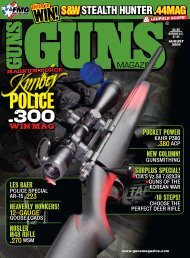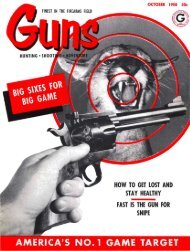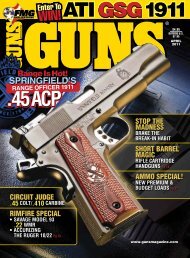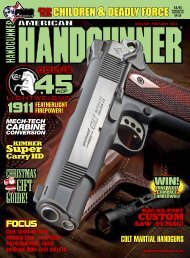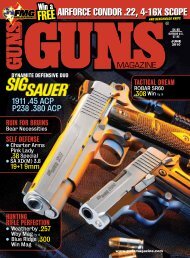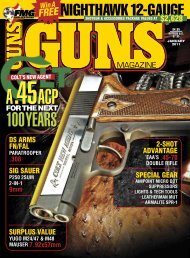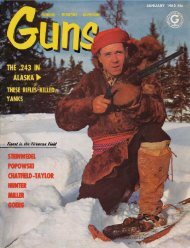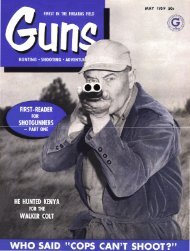Guns 2012-08.pdf - Jeffersonian
Guns 2012-08.pdf - Jeffersonian
Guns 2012-08.pdf - Jeffersonian
Create successful ePaper yourself
Turn your PDF publications into a flip-book with our unique Google optimized e-Paper software.
HOLT<br />
BODINSON<br />
The First Surplus<br />
American Arm?<br />
The National Guard’s first<br />
firearm was a matchlock.<br />
Stepping just inside the permanent exhibit on American<br />
Military History in the National Museum of American<br />
History, you will immediately come face-to-face with a<br />
maple-stocked matchlock musket. Standing a bit over 5' tall<br />
and sporting a .75-caliber bore, it’s an imposing firearm.<br />
What catches your eye though is the name “Newtowne”<br />
burned three times into the stock. The “Newtowne” branding<br />
establishes both the origin of this matchlock as coming from<br />
an early fortified outpost of Boston, established in 1631, and<br />
tasked with maintaining and issuing muskets as well as the<br />
matchlock’s ownership, to the local militia circa 1636.<br />
The Enlisted Association of the<br />
National Guard is selling a stunning,<br />
limited edition reproduction of the<br />
Newtowne militia matchlock as a<br />
fundraiser for their “National Guard<br />
Soldier and Airmen Emergency<br />
Relief Fund.” The fund, part of the<br />
We Care For America Foundation,<br />
was established to provide emergency<br />
grants to National Guard members<br />
who have experienced catastrophic<br />
financial hardship or personal<br />
property losses, ranging from sudden<br />
and long-term mobilizations to house<br />
fires.<br />
Al Garver, Executive Director<br />
of the Enlisted Association and<br />
the person responsible for creating<br />
the Newtowne program, said only<br />
375 Newtowne matchlocks would<br />
be produced, celebrating the 375th<br />
anniversary of the National Guard.<br />
Each gun will be numbered.<br />
We’ve all seen hundreds of<br />
variations of fund-raising appeals, but<br />
in my experience, nothing comes close<br />
to the imaginative and the artistic<br />
quality of the Newtowne matchlock<br />
appeal.<br />
Exacting Reproduction<br />
Built by The Rifle Shoppe of Jones,<br />
Oklahoma, the world’s unparalleled<br />
source of classic and historic<br />
reproduction parts for building<br />
muzzleloading arms of all national<br />
patterns, the Newtowne matchlocks<br />
they’ve crafted are historically<br />
correct and beautifully executed. The<br />
reproduction is so exact you could<br />
swap out their Newtowne for the<br />
original Newtowne in the National<br />
Museum, and no one would know<br />
the better.<br />
Actually, The Rifle Shoppe catalog<br />
begins with parts for assembling<br />
hand “gonnes,” matchlocks and<br />
wheellocks, covers extensively the<br />
250-year reign of the flintlock and<br />
ends with the 40-year pop of the<br />
percussion lock. If you’re interested<br />
at all in historic arms and/or the parts<br />
to make them, The Rifle Shoppe’s<br />
catalog is a must have reference. Nice<br />
folks, too.<br />
In use from the late 1400s to<br />
the early 1700s (except in Japan,<br />
where its employment continued<br />
into the 1800s), the matchlock was<br />
the primary weapon of the early<br />
American settlers. One step up<br />
from the hand cannon, it is a simple<br />
gun, but it could be quite elegant.<br />
Like the .75-caliber Newtowne, the<br />
colonial matchlock was typically a<br />
The Matchlock really has no trigger in the<br />
conventional sense, but has a lever that pivots<br />
the “serpentine” holding the match down into a<br />
pan of powder.<br />
36<br />
WWW.GUNSMAGAZINE.COM • AUGUST <strong>2012</strong>




